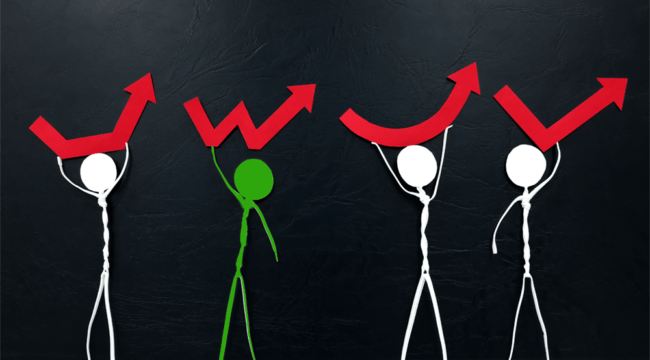Welcome to the “W-shaped” Recovery
In the depths of the pandemic panic and new economic depression this past March and April, happy talk was coming from the White House and Wall Street.
In effect, economic and political leaders said, “Yes, things are bad right now, but don’t worry. We’ll have lots of pent-up demand, and we’ll have a nice V-shaped recovery. By September, things will be back to normal, and the economy will be doing great.”
That turned out to be completely false, as I informed readers at the time.
Here we are in late September, and the pandemic is still with us. Many business lockdowns are happening again after a brief reopening phase in August. Initial claims for unemployment are rising again after dropping in the late summer.
Yes, there is growth, but not nearly enough to pull us out of the deep economic hole we fell into this spring. The recovery is real, but it’s not V-shaped; it’s more of an “L,” with a weak recovery after a severe drop.
Pent-up demand was always a myth. For example, if you skipped ten dinners at a restaurant during the lockdown you weren’t going to order ten meals the next time you went out for dinner. You would have just one.
Yet, are things even worse than an L-shaped recovery?
The evidence is that the recovery is not L-shaped, much less V-shaped. It’s more of a “W” (which means down-up-down-up).
We seem to be hitting a second down-stage, and it may last longer than the down-stage of March and April. We’re facing a global slowdown when the economy should be rebounding.
This may explain why the historic stock market rebound that began on March 23 and took the S&P and NASDAQ to new all-time highs stalled out on September 2 and has been struggling ever since.
The election adds a new element of volatility to this already volatile mix.
Investors should reduce equity exposures, increase their cash allocations and make sure they have at least 10% gold bullion (or, at least gold mining shares) in their portfolios.
That will enable you to weather the storm, at least until we get more visibility in the economic and political landscape in December.
Meanwhile, the nation’s finances are sinking deeper into the red.
The Congressional Budget Office (CBO) is the official referee of budget deficits or surpluses for the U.S. Congress. Its views are also closely watched by the White House since spending and tax bills have to move through Congress anyway.
CBO earns a lot of respect and deference in part because they are “non-partisan” (although like everything in Washington they tilt left) and “expert” (they have a lot of budget geeks who don’t get too involved in politics away from their CBO duties).
That said, there’s a lot to disagree with in CBO estimates. The first thing is that their budget deficit estimates are consistently wrong. Deficits come in about $200 billion (or more) worse than CBO estimates year after year.
The second thing is that they compute a debt-to-GDP ratio (a critical gauge of fiscal solvency and investor confidence) without counting U.S. Treasury debt held in Social Security trust fund accounts. They only look at debt “held by the public.”
That’s ridiculous. Do they actually believe that the Social Security Administration doesn’t rely on Treasury debt being paid on time and as agreed in meeting obligations to retirees and orphans?
The difference is significant. When you count all government debt, the debt-to-GDP ratio is around 135%, which is well in the danger zone (anything greater than 90%) and puts the U.S. in the same league as Greece, Italy and Lebanon.
If you count using the CBO method, the ratio is 98%. That’s still dangerously high, but not quite as scary.
Even using rosy scenario projections and not counting debt held by Social Security, the CBO is sounding an alarm. CBO actually uses the word “unsustainable” in describing the path that the Federal deficit is on.
They say that by 2050, federal spending will be 31% of GDP, but Federal taxes will be only 19% of GDP. That’s a budget deficit of 12% of GDP (usually anything over 3% or 4% is cause for alarm).
We’re looking at multi-trillion-dollar deficits as far as the eye can see. Many critics yell about the fact that we “can’t pay off the debt.” Actually, you never have to pay it off, you just have to roll it over with new debt. That’s what analysts mean by “sustainable.”
When debt becomes unsustainable it means you’re heading for a crack-up, which includes either default, restructuring or high inflation. Take your pick; they’re all bad outcomes.
CBO is saying one of those outcomes is heading our way.
Can monetary or fiscal policy lead us out of the new depression?
Regards,
Jim Rickards
for The Daily Reckoning



Comments: